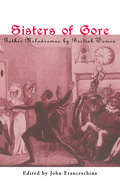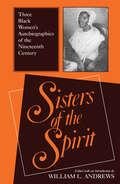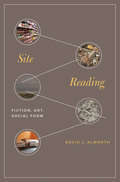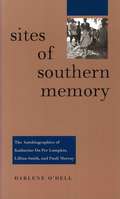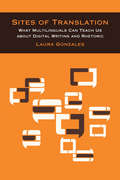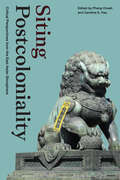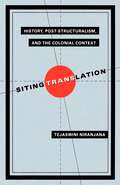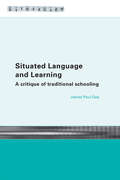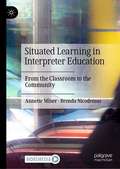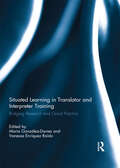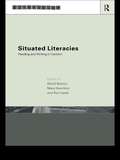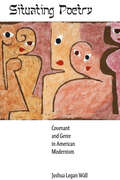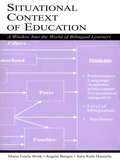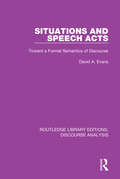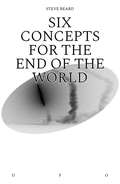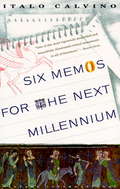- Table View
- List View
Sisters of Gore: Seven Gothic Melodramas by British Women, 1790-1843 (Garland Reference Library Of The Humanities Ser.)
by John FranceschinaThe plays collected in Sisters of Gore span the development of Gothic melodrama from the 1790s to the 1840s.
Sisters of Tomorrow: The First Women of Science Fiction (Early Classics Of Science Fiction Ser.)
by Lisa Yaszek and Patrick B. SharpAnthology of stories, essays, poems, and illustrations by the women of early science fiction For nearly half a century, feminist scholars, writers, and fans have successfully challenged the notion that science fiction is all about "boys and their toys," pointing to authors such as Mary Shelley, Clare Winger Harris, and Judith Merril as proof that women have always been part of the genre. Continuing this tradition, Sisters of Tomorrow: The First Women of Science Fiction offers readers a comprehensive selection of works by genre luminaries, including author C. L. Moore, artist Margaret Brundage, and others who were well known in their day, including poet Julia Boynton Green, science journalist L. Taylor Hansen, and editor Mary Gnaedinger. Providing insightful commentary and context, this anthology documents how women in the early twentieth century contributed to the pulp-magazine community and showcases the content they produced, including short stories, editorial work, illustrations, poetry, and science journalism. Yaszek and Sharp's critical annotation and author biographies link women's work in the early science fiction community to larger patterns of feminine literary and cultural production in turn-of-the-twentieth-century America. In a concluding essay, the award-winning author Kathleen Ann Goonan considers such work in relation to the history of women in science and engineering and to the contemporary science fiction community itself.
Sisters of the Spirit: Three Black Women's Autobiographies of the Nineteenth Century (Religion In North America Ser.)
by William L. Andrews"Sisters of the Spirit . . . should interest a wider audience. . . . These fascinating accounts can stand on their own. . . . Mr. Andrews has made them even more accessible by providing a comprehensive introduction and helpful footnotes . . . but he does not intrude on the text itself." —New York Times Book Review" . . . informative and inspiring reading." —The Journal of American HistoryJarena Lee, Zilpha Elaw, and Julia Foote underwent a revolution in their own sense of self that helped to launch a feminist revolution in American religious life and in American society as a whole.
Site Reading
by David J. AlworthSite Reading offers a new method of literary and cultural interpretation and a new theory of narrative setting by examining five sites--supermarkets, dumps, roads, ruins, and asylums--that have been crucial to American literature and visual art since the mid-twentieth century. Against the traditional understanding of setting as a static background for narrative action and character development, David Alworth argues that sites figure in novels as social agents. Engaging a wide range of social and cultural theorists, especially Bruno Latour and Erving Goffman, Site Reading examines how the literary figuration of real, material environments reorients our sense of social relations. To read the sites of fiction, Alworth demonstrates, is to reveal literature as a profound sociological resource, one that simultaneously models and theorizes collective life.Each chapter identifies a particular site as a point of contact for writers and artists--the supermarket for Don DeLillo and Andy Warhol; the dump for William Burroughs and Mierle Laderman Ukeles; the road for Jack Kerouac, Joan Didion, and John Chamberlain; the ruin for Thomas Pynchon and Robert Smithson; and the asylum for Ralph Ellison, Gordon Parks, and Jeff Wall--and shows how this site mediates complex interactions among humans and nonhumans. The result is an interdisciplinary study of American culture that brings together literature, visual art, and social theory to develop a new sociology of literature that emphasizes the sociology in literature.
Sites Unseen: Architecture, Race, and American Literature (America and the Long 19th Century #23)
by William A. GleasonSites Unseen examines the complex intertwining of race and architecture in nineteenth and early-twentieth century American culture, the period not only in which American architecture came of age professionally in the U.S. but also in which ideas about architecture became a prominent part of broader conversations about American culture, history, politics, and—although we have not yet understood this clearly—race relations. This rich and copiously illustrated interdisciplinary study explores the ways that American writing between roughly 1850 and 1930 concerned itself, often intensely, with the racial implications of architectural space primarily, but not exclusively, through domestic architecture.In addition to identifying an archive of provocative primary materials, Sites Unseen draws significantly on important recent scholarship in multiple fields ranging from literature, history, and material culture to architecture, cultural geography, and urban planning. Together the chapters interrogate a variety of expressive American vernacular forms, including the dialect tale, the novel of empire, letters, and pulp stories, along with the plantation cabin, the West Indian cottage, the Latin American plaza, and the “Oriental” parlor. These are some of the overlooked plots and structures that can and should inform a more comprehensive consideration of the literary and cultural meanings of American architecture. Making sense of the relations between architecture, race, and American writing of the long nineteenth century—in their regional, national, and hemispheric contexts—Sites Unseen provides a clearer view not only of this catalytic era but also more broadly of what architectural historian Dell Upton has aptly termed the social experience of the built environment.
Sites of Southern Memory: The Autobiographies of Katharine Du Pre Lumpkin, Lillian Smith, and Pauli Murray
by Darlene O'DellIn southern graveyards through the first decades of the twentieth century, the Confederate South was commemorated by tombstones and memorials, in Confederate flags, and in Memorial Day speeches and burial rituals. Cemeteries spoke the language of southern memory, and identity was displayed in ritualistic form--inscribed on tombs, in texts, and in bodily memories and messages. Katharine DuPre Lumpkin, Lillian Smith, and Pauli Murray wove sites of regional memory, particularly Confederate burial sites, into their autobiographies as a way of emphasizing how segregation divided more than just southern landscapes and people.Darlene O'Dell here considers the southern graveyard as one of three sites of memory--the other two being the southern body and southern memoir--upon which the region's catastrophic race relations are inscribed. O'Dell shows how Lumpkin, Smith, and Murray, all witnesses to commemorations of the Confederacy and efforts to maintain the social order of the New South, contended through their autobiographies against Lost Cause versions of southern identity. Sites of Southern Memory elucidates the ways in which these three writers joined in the dialogue on regional memory by placing the dead southern body as a site of memory within their texts. In this unique study of three women whose literary and personal lives were vitally concerned with southern race relations and the struggle for social justice, O'Dell provides a telling portrait of the troubled intellectual, literary, cultural, and social history of the American South.
Sites of Translation: What Multilinguals Can Teach Us about Digital Writing and Rhetoric (Sweetland Digital Rhetoric Collaborative)
by Laura GonzalesWinner of the 2016 Sweetland Digital Rhetoric Collaborative Book Prize Sites of Translation illustrates the intricate rhetorical work that multilingual communicators engage in as they translate information for their communities. Blending ethnographic and empirical methods from multiple disciplines, Laura Gonzales provides methodological examples of how linguistic diversity can be studied in practice, both in and outside the classroom, and provides insights into the rhetorical labor that is often unacknowledged and made invisible in multilingual communication. Sites of Translation is relevant to researchers and teachers of writing as well as technology designers interested in creating systems, pedagogies, and platforms that will be more accessible and useful to multilingual audiences. Gonzales presents multilingual communication as intellectual labor that should be further valued in both academic and professional spaces, and supported by multilingual technologies and pedagogies that center the expertise of linguistically diverse communicators.
Siting Postcoloniality: Critical Perspectives from the East Asian Sinosphere (Sinotheory)
by Pheng Cheah and Caroline S. HauThe contributors to Siting Postcoloniality reevaluate the notion of the postcolonial by focusing on the Sinosphere—the region of East and Southeast Asia that has been significantly shaped by relations with China throughout history. Pointing out that the history of imperialism in China and Southeast Asia is longer and more complex than Euro-American imperialism, the contributors complicate the traditional postcolonial binaries of center-periphery, colonizer-colonized, and developed-developing. Among other topics, they examine socialist China’s attempts to break with Soviet cultural hegemony, the postcoloniality of Taiwan as it negotiates the legacy of Japanese colonial rule, Southeast Asian and South Asian diasporic experiences of colonialism, and Hong Kong’s complex colonial experiences under the British, the Japanese, and mainland China. The contributors show how postcolonial theory’s central concepts cannot adequately explain colonialism in the Sinosphere. Challenging fundamental axioms of postcolonial studies, the volume forcefully suggests that postcolonial theory needs to be rethought.Contributors. Pheng Cheah, Dai Jinhua, Caroline S. Hau, Elaine Yee Lin Ho, Wendy Larson, Liao Ping-hui, Lin Pei-yin, Lo Kwai-Cheung, Lui Tai-lok, Pang Laikwan, Lisa Rofel, David Wang, Erebus Wong, Robert J. C. Young
Siting Translation: History, Post-Structuralism, and the Colonial Context
by Tejaswini NiranjanaThe act of translation, Tejaswini Niranjana maintains, is a political action. Niranjana draws on Benjamin, Derrida, and de Man to show that translation has long been a site for perpetuating the unequal power relations among peoples, races, and languages. The traditional view of translation underwritten by Western philosophy helped colonialism to construct the exotic "other" as unchanging and outside history, and thus easier both to appropriate and control.Scholars, administrators, and missionaries in colonial India translated the colonized people's literature in order to extend the bounds of empire. Examining translations of Indian texts from the eighteenth century to the present, Niranjana urges post-colonial peoples to reconceive translation as a site for resistance and transformation.
Sitting in Darkness: Mark Twain's Asia and Comparative Racialization (America and the Long 19th Century #7)
by Hsuan L. HsuPerhaps the most popular of all canonicalAmerican authors, Mark Twain is famous for creating works that satirizeAmerican formations of race and empire. While many scholars have exploredTwain’s work in African Americanist contexts, his writing on Asia and AsianAmericans remains largely in the shadows. In Sitting in Darkness, Hsuan Hsuexamines Twain’s career-long archive of writings about United States relationswith China and the Philippines. Comparing Twain’s early writings about Chineseimmigrants in California and Nevada with his later fictions of slavery andanti-imperialist essays, he demonstrates that Twain’s ideas about race were notlimited to white and black, but profoundly comparative as he carefully craftedassessments of racialization that drew connections between groups, includingAfrican Americans, Chinese immigrants, and a range of colonial populations.Drawing on recent legal scholarship,comparative ethnic studies, and transnational and American studies, Sitting inDarkness engages Twain’s best-known novels such as Tom Sawyer, HuckleberryFinn, and A Connecticut Yankee in King Arthur’s Court, as well as hislesser-known Chinese and trans-Pacific inflected writings, such as theallegorical tale “A Fable of the Yellow Terror” and the yellow face play AhSin. Sitting in Darkness reveals how within intersectional contexts of ChineseExclusion and Jim Crow, these writings registered fluctuating connectionsbetween immigration policy, imperialist ventures, and racism.
Sitton Spelling And Word Skills Practice Book 3: Level 3 The Zoo
by Rebecca SittonSpelling Practice Book For Grade 3
Sitton Spelling and Word Skills Practice Book 4
by Rebecca Sitton Donna BernardNIMAC-sourced textbook
Situated Language and Learning: A Critique of Traditional Schooling (Literacies)
by James Paul GeeWhy do poor and minority students under-perform in school? Do computer games help or hinder learning? What can new research in psychology teach our educational policy-makers?In this major new book, Gee tackles the 'big ideas' about language, literacy and learning, putting forward an integrated theory that crosses disciplinary boundaries, and applying it to some of the very real problems that face educationalists today.Situated Language and Learning looks at the specialist academic varieties of language that are used in disciplines such as mathematics and the sciences. It argues that the language acquisition process needed to learn these forms of language is not given enough attention by schools, and that this places unfair demands on poor and minority students.The book compares this with learning as a process outside the classroom, applying this idea to computer and video games, and exploring the particular processes of learning which take place as a child interacts with others and technology to learn and play. In doing so, Gee examines what video games can teach us about how to improve learning in schools and engages with current debates on subjects such as 'communities of practice' and 'digital literacies'.Bringing together the latest research from a number of disciplines, Situated Language and Learning is a bold and controversial book by a leading figure in the field, and is essential reading for anyone interested in education and language.
Situated Learning in Interpreter Education: From the Classroom to the Community
by Brenda Nicodemus Annette MinerThis book provides a theoretical and pragmatic guide to the use of situated learning within structured interpreting programs. Proponents of situated learning theory believe that meaningful learning occurs when students interact with others in the social contexts in which they will be working. With such interactions, students have the opportunity to apply their theoretical knowledge to authentic contexts that they will encounter throughout their professional lives. While a limited number of research articles exist about the use of situated learning in interpreter education, this is the first full book to provide the foundations for situated learning theory, show how to implement situated learning in interpreter education, and offer practical applications for maximizing authenticity in interpreting classrooms.
Situated Learning in Translator and Interpreter Training: Bridging research and good practice
by Maria González-Davies and Vanessa Enríquez RaídoSituated Learning is generally understood as a context-dependent approach to translator and interpreter training under which learners are exposed to real-life and/or highly simulated collaborative work environments and tasks, both inside and outside the classroom. Ultimately, Situated Learning seeks to enhance learners’ capacity to think and act like professionals. This book sets out to gauge the extent to which different factors influence the implementation of Situated Learning models in various teaching and learning contexts. It presents an understanding of Situated Learning that goes beyond previous interpretations of this notion, traditionally dominated by the discussion of pedagogical practices in authentic, i.e. real-world, or semi-authentic professional settings. This wider remit of Situated Learning encompasses previously underrepresented contextual factors pertaining to translation traditions, historical trends, community beliefs and customs, socio-economic constraints, market conditions, institutional practices, budgetary issues, or resource availability. The pedagogical considerations of these key aspects make this book particularly useful for both novice and seasoned teachers of translation and interpreting with an interest in informed practical advice on how to implement the principles of Situated Learning in collaborative teaching and learning environments that seek to promote translators’ and/or interpreters’ professional competence. This book was originally published as a special issue of The Interpreter and Translator Trainer.
Situated Learning: Legitimate Peripheral Participation (The Macat Library)
by Charmi PatelSocial anthropologist Jean Lave and computer scientist Etienne Wenger’s seminal Situated Learning helped change the fields of cognitive science and pedagogy by approaching learning from a novel angle. Traditionally, theories of learning and education had focused on processes of cognition – the mental processes of knowledge formation that occur within an individual. Lave and Wenger chose to look at learning not as an individual process, but a social one. As so often with the creative thinking process, a small, simple shift in emphasis was all that was required to show things in an entirely different light. What Situated Learning illustrated – and emphasized – was that learning is dependent on its social situation. Even though the most effective way to learn is through interaction with experts and peers in a community organized around a common interest, the traditional cognitive learning model failed to account for the way in which learners interact with their ‘community of practice.’ The new hypothesis that Lave and Wenger developed was that learning can be seen as a continuously evolving set of relationships situated within a social context. This allowed Lave and Wenger to place discussions of apprenticeship and workplace learning on a new footing – and led in turn to the book’s impressive impact in business and management scholarship.
Situated Literacies: Theorising Reading and Writing in Context (Literacies)
by David Barton Mary Hamilton Roz IvaničSituated Literacies is a rich and varied collection of key writings from leading international scholars in the field of literacy. Each contribution, written in a clear, accessible style, makes the link between literacies in specific contexts and broader social practices.Detailed ethnographic studies of a wide variety of specific situations, all involving real texts and lived practices, are balanced with general claims about the nature of literacy. Contributors address a coherent set of issues:* the visual and material aspects of literacy* concepts of time and space in relation to literacy* the functions of literacies in shaping and sustaining identities in communities of practice* the relationship between texts and the practices associated with their usethe role of discourse analysis on literacy studiesThese studies, along with a foreword by Denny Taylor, make a timely and important contribution to literacy theory and suggest directions for the further development of the field. Situated Literacies is essential reading for anyone involved in literary education.
Situating Poetry: Covenant and Genre in American Modernism
by Joshua Logan WallA retelling of American modernism through the lines of solidarity and division within and among ethnic and religious identities found in poetry.What happens if we approach the reading and writing of poetry not as an individual act, but as a public one? Answering this question challenges common assumptions about modern poetry and requires that we explore the important questions that define genre: Where is this poem situated, and how did it get there?Joshua Logan Wall's Situating Poetry studies five poets of the New York literary scene rarely considered together: James Weldon Johnson, Charles Reznikoff, Lola Ridge, Louis Zukofsky, and Robert Hayden. Charting their works and careers from 1910–1940, Wall illustrates how these politically marginalized writers from drastically different religious backgrounds wrestled with their status as American outsiders. These poets produced a secularized version of America in which poetry, rather than God, governed individual obligations to one another across multiethnic barriers.Adopting a multiethnic and pluralist approach, Wall argues that each of these poets—two Black, two Jewish, and one Irish-American anarchist—shares a desire to create more truly democratic communities through art and through the covenantal publics created by their poems despite otherwise sitting uncomfortably, at best, within a more standard literary history. In this unique account of American modernist poetics, religious pluralism creates a lens through which to consider the bounds of solidarity and division within and among ethnic identities and their corresponding literatures.
Situation Critical: Critique, Theory, and Early American Studies
by Max Cavitch and Brian Connolly, eds.The contributors to Situation Critical argue for the continued importance of critique to early American studies, pushing back against both reductivist neo-empiricism and so-called postcritique. Bringing together essays by a diverse group of historians and literary scholars, editors Max Cavitch and Brian Connolly demonstrate that critique is about acknowledging that we are never simply writing better or worse accounts of the past, but accounts of the present as well. The contributors examine topics ranging from the indeterminacy of knowledge and history to Black speculative writing and nineteenth-century epistemology, the role of the unconscious in settler colonialism, and early American writing about masturbation, repression, religion, and secularism and their respective influence on morality. The contributors also offer vital new interpretations of major lines of thought in the history of critique—especially those relating to Freud and Foucault—that will be valuable both for scholars of early American studies and for scholars of the humanities and interpretive social sciences more broadly.Contributors. Max Cavitch, Brian Connolly, Matthew Crow, John J. Garcia, Christopher Looby, Michael Meranze, Mark J. Miller, Justine S. Murison, Britt Rusert, Ana Schwartz, Joan W. Scott, Jordan Alexander Stein
Situational Context of Education: A Window Into the World of Bilingual Learners
by Mar¡a Estela Brisk Angela Burgos Sara Ruth HamerlaThis book gives educators important answers to the urgent question of how teachers and schools can facilitate language minority and immigrant students' progress in school. It offers an innovative and powerful method teachers and students can use to study the situational context of education, providing both the theoretical background and the practical tools to implement this approach. The situational context of education includes linguistic, economic, social, cultural, and political factors, as well as conditions, such as students' personal characteristics, family support, and quality of instruction. All of these factors influence the lives of students and their academic performance and contribute in many ways, some subtle and indirect, to making the educational experience more or less difficult for different students. The premise of the book is that objective study of the situational context of education by both students and teachers is beneficial because it leads to a more realistic view of how to facilitate students' progress in school. Designed as a text for graduate courses for preservice and in-service teachers working with students in bilingual, ESL, mainstream, and special education classrooms, the goal is to engage readers in learning not only from the literature but also from studying the situational contexts of their own students. The focus here is on the factors that affect language minority and immigrant students in the United States, but the framework is equally powerful for work with student populations in other social contexts. *The Introduction includes an overview of the theory behind the study of the situational context of education and the implementation of this approach; describes the context of the pilot lessons included in the book; and explains how to use the lessons detailed in later chapters. *Chapters 2-6 focus on different factors in the situational context of education: linguistic, economic, social, cultural, and political. A three-part structure is used: "Classroom Implementation" (a rich description of one lesson in a real classroom); "Context Variables" (a theoretical explanation of the specific factor the chapter addresses, providing the research basis for the sample lesson objectives ); "Doing Analysis of the Context" (several sample lessons for implementation). The lessons are addressed to the teacher, with detailed ideas on how to carry out the lesson and evaluate the students' understanding of the situational context. *Five Appendices provide helpful resources for the implementation of the lessons: an Annotated bibliography of relevant K-12 children's literature; Instructional Approaches; Scoring Rubrics for Content Objectives; Guidelines for a Contrastive Study of Situational Context; and Lesson Template. The lessons have been thoroughly field-tested with students and teachers. Because these lessons work on multiple levels, Situational Context of Education: A Window Into the World of Bilingual Learners benefits students from first grade through preservice and in-service teachers in university courses. Teachers get to know their students and their predicaments within the social context of the United States, and at the same time, the lesson activities have a great impact on the students in their classes. All are helped to achieve academically while gaining awareness of situational factors affecting their lives.
Situational Privacy and Self-Disclosure: Communication Processes in Online Environments
by Philipp K. MasurUsing both a theoretical argumentation and an empirical investigation, this book rationalizes the view that in order to understand people’s privacy perceptions and behaviors, a situational perspective needs to be adopted.To this end, the book is divided into three parts. Part I advances the theory of situational privacy and self-disclosure by discussing impacts of new information and communication technologies on traditional theories of privacy and self-disclosure. Based on five basic suppositions, it describes three major processes of the theory: pre-situational privacy regulations processes, situational privacy perception and self-disclosure processes, and post-situational evaluation processes. Next, Part II presents the application of the theory to smartphone-based communication. It first analyses how people choose certain communication environments on their smartphones, how they manipulate them, and how these external factors affect self-disclosure within these environments. It then details a multi-method study conducted to test the derived assumptions and discusses the obtained results. Part III reflects on the overall implications of the theory, summarizes the major findings and lastly considers possible extensions and perspectives on future research.Intended mainly for researchers in privacy and communication studies, the book offers privacy scholars a systematic review of both classic and contemporary theories of privacy and self-disclosure. At the same time, communication scholars benefit from an additional methodological discussion of the mobile experience sampling method, which provides an invaluable approach to measuring situational communication processes.
Situations and Speech Acts: Toward a Formal Semantics of Discourse (RLE: Discourse Analysis)
by David A. EvansFirst published in 1985, this book aims to develop an approach to speech acts that has the virtue of being straight-forward, explicit, formal and flexible enough to accommodate many of the more general problems of interactive verbal communication. The first chapter introduces situation semantics with the second addressing the assumptions implied by the problem of representing speaker intentionality. The third chapter presents a streamlined theory of speech acts and the fourth tests the predictions of the theory in several hypothetical discourse situations. A summary and suggestions for further research is provided in chapter five, and appendices facilitate reference to key concepts.
Six Characters in Search of an Author (SparkNotes Literature Guide Series)
by SparkNotesSix Characters in Search of an Author (SparkNotes Literature Guide) by Luigi Pirandello Making the reading experience fun! Created by Harvard students for students everywhere, SparkNotes is a new breed of study guide: smarter, better, faster. Geared to what today's students need to know, SparkNotes provides: *Chapter-by-chapter analysis *Explanations of key themes, motifs, and symbols *A review quiz and essay topicsLively and accessible, these guides are perfect for late-night studying and writing papers
Six Concepts for the End of the World (Goldsmiths Press / Unidentified Fictional Objects)
by Steve BeardA navigational aid to the apocalypse.Steve Beard's Six Concepts for the End of the World mixes scientific research with experimental fiction to produce a manual for the apocalypse. The author examines six disciplines—technology, sociology, geography, psychology, theology and narratology—and for each one creates a fictional scenario that both reflects and energizes the research, all under the guiding light of the philosopher Paul Virilio's theories. This approach allows Beard to create one surprising idea after another: Hollywood viewed as a research and development lab for the end times, a first-person account of a UFO abduction, a blog on the disappearance of the Malaysian Airlines flight 370, a voice-over for an imaginary film by a doomsday cult member. Highly original in both form and content, the book surprises and delights in its scope. The approach is multidisciplinary and multidirectional, and Beard's exploration ranges over many areas and themes, always bringing distinctive insights to bear. Six Concepts for the End of the World is an expertly guided tour through the author's imagination, and toward the end of the world.
Six Memos for the Next Millennium
by Italo Calvino Patrick CreaghSix Memos for the Millennium is a collection of five lectures Italo Calvino was about to deliver at the time of his death. Here is his legacy to us: the universal values he pinpoints become the watchwords for our appreciation of Calvino himself.What should be cherished in literature? Calvino devotes one lecture, or memo to the reader, to each of five indispensable qualities: lightness, quickness, exactitude, visibility, and multiplicity. A sixth lecture, on consistency, was never committed to paper, and we are left only to ponder the possibilities. With this book, he gives us the most eloquent defense of literature written in the twentieth century--a fitting gift for the next millennium.From the Trade Paperback edition.
